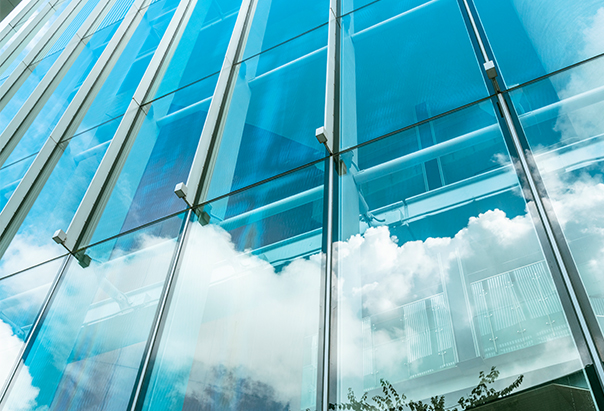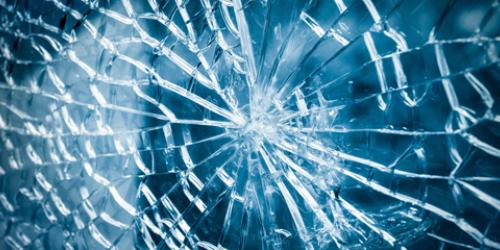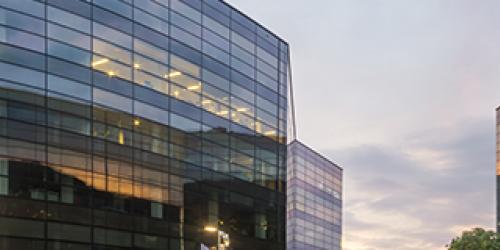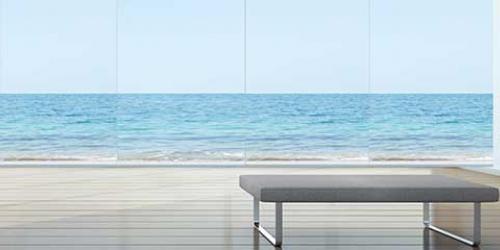What it takes to be safety glass
Glass has been meeting safety test requirements since 1966, when ANSI Z97.1 Safety Glazing Materials Used in Buildings, Safety Performance Specifications and Methods of Test was first published. There are three types of glass that are typically classified as safety glazing: tempered, organic coated, and laminated. Since 1966, other standards for safety glass have developed regionally using the same principles, including AS/NZ 2208 (Australia/New Zealand), CAN CGSB 12.1 (Canada), CNS 1183 (Taiwan), CPSC 16 CFR 1201 (United States), EN 12600 (Europe), GB 9656 (China), and ISO 29584.
Tempered glass
Tempered glass is produced by treating annealed glass to cause the surface to compress while simultaneously putting the center of the glass in tension. This can be done with heat or chemicals. The glass must break in a manner that reduces the likelihood of cutting and piercing injuries to humans when breakage occurs from impact. Tempered glass tends to require significant blunt force or a concentrated point type impact to break. Once the surface compression layer is penetrated, the glass will shatter.
For heat-tempered glass, breakage tends to result in a loud pop as the energy is released, with the glass vacating the opening and glass particles spraying a good distance from the origin creating falling or flying “cubes” or “patches” of glass. There are requirements for the maximum size of the glass “cubes” as determined by the number of pieces within a specified area.
Tempered glass offers approximately four times more glass strength than annealed glass. Because of this, it is often used as a mechanism for thinner glass or larger panels of glass under a specific load. Tempered glass made via heat-treatment method may exhibit optical properties such as roller waves and anisotropy. Heat-tempered glass is commonly found in storefronts, facades, and the side and back glass of some cars.
Chemically tempered safety glass uses the same principles, but the glass is strengthened through a chemical exchange at the surface. This type of glass tends to be thinner, such as the glass on your cell phone. But technology is advancing to allow thicker and larger glass to be made in this manner. Chemically tempered safety glass is subjected to the same glass breakage size requirements as heat-tempered safety glass. Usually, the technology used for chemically strengthened glass does not produce roller waves.
Tempered glass has the same properties as annealed glass for solar, thermal, color and acoustic.
Organic coated glass
Organic coated glass is typically an annealed glass with a thin film applied to the surface. This film may hold the glass together when broken to help reduce cutting and piercing injuries. The same requirements for impact and glass shard retention and particle size apply to organic coated safety glazing as other products. The safety standards were written to encompass mirror backing and the use of this product in applications where human impact can occur (closet doors), but they have been extended to any organic coated glass, including filmed interior glass or facades.
Laminated glass
Laminated glass is an assembly of glass and Saflex® or Vanceva® PVB interlayers. The glass can be annealed, heat-strengthened, fully tempered, chemically strengthened, patterned, coated, fritted, etc. Two or more pieces of glass are bonded with an interlayer to bring valuable properties to the laminated unit.
For safety glazing, the interlayer provides resistance to impact penetration. Once the glass breaks from the initial impact, the interlayer allows the energy of the impact to be absorbed as it stretches along the cracks and fissures, causing the telltale spider-web break pattern. The interlayer acts as a solid elastic web, expanding, thinning, and intentionally allowing for micro-delamination to help prevent penetration while, at the same time, tenaciously hanging onto the glass shards to help prevent pieces of glass from flying or falling off the laminated glass unit. Some of the safety glazing standards even have limits on how much glass can be released from the laminated unit on impact and still qualify as safety glazing.
All safety glazing standards require that, after impact, no opening be created in the laminated unit through which a solid steel ball the size of a tennis ball could fit through without a lot of force. This means that the laminated unit cannot vacate the opening and is the reason laminated glass is the required product for overhead or sloped glazing in many parts of the world.
For most applications, laminated glass with conventional Saflex Clear PVB interlayer is deemed to have glass strength similar to the equivalent nominal thickness of total glass used to construct the laminate. In addition to the ability of the interlayer to hold onto the broken glass shards, laminated glass can also bring other valuable performance attributes such as security, sound abatement, solar control, color, reduction of fading, and storm protection. Using Saflex Structural (DG) interlayer may also offer enhanced structural capabilities.
Better together
Laminated glass offers many attributes over nonlaminated constructions. Based on the innate need to use two or more pieces of glass and interlayer to create laminated glass, the unique ability to select specific components to meet the project needs are almost limitless and offer even greater glazing enhancement opportunities.
The combination of strengthened glasses with interlayers creates design opportunities that are mind boggling. Combinations of interlayers and tempered glass can be used to meet load requirements, reduce the thickness of glass, increase the overall glass size, or add security protection for blast, ballistics, and forced entry/exit. The laminated units may be clear or colored, symmetrical or asymmetrical, flat or curved, and used vertically or horizontally in both underfoot and overhead applications. The use of filmed glass in conjunction with laminated glass can offer spall protection in some security applications as well as offer decorative and energy performance advantages.
Laminates need glass—all kinds of glass. And glass needs to perform in ways today that it has never had to before. That is why laminating glass with heat-strengthened and tempered glass plies and surface-applied films is one of the most intriguing and exciting glazing options in architecture today.










